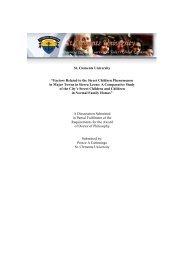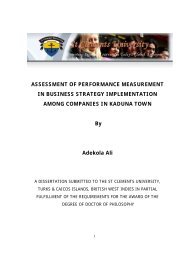The role of informal microfinance institutions in saving
The role of informal microfinance institutions in saving
The role of informal microfinance institutions in saving
You also want an ePaper? Increase the reach of your titles
YUMPU automatically turns print PDFs into web optimized ePapers that Google loves.
Primary Education (UPE) <strong>in</strong> 1977. Universal health was adopted and resulted <strong>in</strong>to the<br />
expansion <strong>of</strong> rural health centers all over the country. More population became covered by<br />
improved water sources. Aggregate cash crop growers’ <strong>in</strong>come <strong>in</strong>creased substantially partly<br />
due to improvement <strong>of</strong> rural/urban terms <strong>of</strong> trade over 1967-1970 and <strong>in</strong> 1974-1084.<br />
On the basis <strong>of</strong> wage distribution <strong>in</strong> formal sector dur<strong>in</strong>g the 1967/1970-1994/1995 period,<br />
Government and parastatals wages and salaries (by that time the Government and parastatals<br />
were ma<strong>in</strong> employers) were relatively evenly distributed, with reduction <strong>of</strong> <strong>in</strong>equality com<strong>in</strong>g<br />
through substantial <strong>in</strong>crease at the bottom; and application <strong>of</strong> modest progressive tax <strong>of</strong> wages<br />
that take <strong>in</strong>to account the cost <strong>of</strong> liv<strong>in</strong>g (Bank <strong>of</strong> Tanzania, 1981). <strong>The</strong> ratio <strong>of</strong> average salaries<br />
between top 10 percent employees to bottom 60 percent employees fell from 10.9 <strong>in</strong> 1965 to<br />
8.6 <strong>in</strong> 1969, 4.7 <strong>in</strong> 1976, 3.5 <strong>in</strong> 1981 and 3.1 <strong>in</strong> 1985. Likewise, <strong>in</strong> parastatal sector, the ratio <strong>of</strong><br />
top 10 percent to bottom 60 percent employees fell from 6.8 <strong>in</strong> 1974 to 6.0 <strong>in</strong> 1981, 5.7 <strong>in</strong><br />
1985 and 4.8 1n i990.<br />
<strong>The</strong>se redistributive measures (<strong>in</strong> both rural and urban areas) <strong>in</strong> the 1967-1989 period enabled<br />
to <strong>in</strong>crease susta<strong>in</strong>ability the share <strong>of</strong> private <strong>in</strong>come and consumption expenditure received<br />
by the lowest 20 percent households, <strong>in</strong> l<strong>in</strong>e with GDP growth. While real GDP grew to an<br />
average <strong>of</strong> TZS 5,335.0 millions <strong>in</strong> 1968-71, TZS 6,488.3 millions <strong>in</strong> 1972-75, TZS 7,866.0<br />
millions <strong>in</strong> 1976-79, TZS 8369.0 millions <strong>in</strong> 1980-83; and TZS 10,541.0 Millions <strong>in</strong> 1984-87;<br />
the share <strong>of</strong> private <strong>in</strong>come received by the lowest 20 percent.<br />
Households were recorded at an average <strong>of</strong> 2.09 percent <strong>in</strong> 1965-68, 2.68 percent <strong>in</strong> 1969-72,<br />
4.25 percent <strong>in</strong> 1973-76, 5.50 percent <strong>in</strong> 1977-80, 6.50 percent <strong>in</strong> 1981-84 and 5.31 percent <strong>in</strong><br />
1985-88. <strong>The</strong> share <strong>of</strong> private consumption expenditure received by the lowest 20 percent<br />
households <strong>in</strong>creased from an average <strong>of</strong> 3.70 percent <strong>in</strong> 1965-68, to an average <strong>of</strong> 5.72<br />
percent <strong>in</strong> 1969-72, 7.45 percent <strong>in</strong> 19973-76, 9.12 percent <strong>in</strong> 1977-80, 9.20 percent <strong>in</strong> 1981-<br />
84 and 9.70 percent <strong>in</strong> 1985-88.<br />
84
















